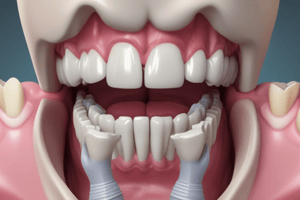Podcast
Questions and Answers
What is the characteristic of the permanent incisors eruption?
What is the characteristic of the permanent incisors eruption?
- They are vertically inclined
- They tend to decrease the dental arch perimeter
- They have no effect on the dental arch perimeter
- They tend to increase the dental arch perimeter (correct)
What is the term given to the stage where the maxillary and mandibular arches consist of sets of deciduous and permanent teeth?
What is the term given to the stage where the maxillary and mandibular arches consist of sets of deciduous and permanent teeth?
- Self correcting annomaly
- Broadbent phenomenon
- Ugly duckiling stage
- Inter-transitional stage (correct)
In the inter-transitional stage, what is the relationship between the 2 jaws in occlusion?
In the inter-transitional stage, what is the relationship between the 2 jaws in occlusion?
- The anteroposterior relation is not fixed (correct)
- The anteroposterior relation is fixed
- The mandibular teeth are in a more distal position
- There is no interference between the teeth
What is the age range for the replacement of the primary canines and molars?
What is the age range for the replacement of the primary canines and molars?
What is the total leeway space in the maxillary arch?
What is the total leeway space in the maxillary arch?
What is the first contributor to the molar transition?
What is the first contributor to the molar transition?
What is the eruption sequence of the permanent teeth in the maxillary arch?
What is the eruption sequence of the permanent teeth in the maxillary arch?
What is the last major change that occurs in the occlusion of the permanent teeth?
What is the last major change that occurs in the occlusion of the permanent teeth?
What is the characteristic of the mandible during the transition from mixed dentition to permanent dentition?
What is the characteristic of the mandible during the transition from mixed dentition to permanent dentition?
What is the age range for the completion of the permanent dentition?
What is the age range for the completion of the permanent dentition?
Flashcards are hidden until you start studying
Study Notes
Occlusion and Development of Dentition
- Edward Angle described the occlusal relationship in 1899 and introduced the concept of "balanced occlusion" for complete dentures.
- Balanced occlusion is the optimum functional occlusion.
Stages of Dentition Development
- Pre-dentate stage: From birth to 6 months, characterized by gum pads, and ideally ends with the eruption of the first deciduous tooth.
- Deciduous Dentition stage: From 6 months to 6 years, during which the primary teeth erupt, and the sequence of eruption is A-B-D-C-E.
- Mixed Dentition stage: From 6 to 12 years, a transitional period where both primary and permanent teeth are present in the mouth.
- Permanent Dentition stage: From 12 to 14 years, when all 28 permanent teeth are present in the dental arch.
Pre-dentate Stage
- At rest, the gum pads have an anterior open bite, and the upper gum pad is larger than the mandibular gum pad.
- The tongue is interposed between the space, and contact occurs between the upper and lower arch in the first molar region.
Primary Dentition and Occlusion
- Primary teeth begin to erupt at 6 months and are completed by 2.5-3 years.
- The sequence of eruption is A-B-D-C-E, with the mandibular central incisor being the first to erupt.
- Spacing exists between deciduous teeth, known as physiological or developmental spaces.
- The overbite is deep initially, but reduces over time due to the eruption of primary molars, rapid attrition of incisors, and forward movement of the mandible.
Mixed Dentition Stage
- First Transitional period: The first exchange of teeth occurs between 6-8 years, with the eruption of the first permanent molar and the exfoliation of the mandibular central incisor.
- Inter-Transitional period: A relatively stable period where the maxillary and mandibular arches consist of sets of deciduous and permanent teeth.
- Second Transitional period: The replacement of the primary canines and molars occurs between 10-12 years, with the leeway space of Nance playing a significant role.
Terminal Plane Relations
- Flush Terminal plane: The shift in molar from a flush terminal plane to a Class I relation can occur in two ways: early shift or late shift.
- Mesial Step Terminal plane: The distal surface of the lower second deciduous molar is more mesial than the upper, leading to an Angle Class I occlusion.
- Distal Step Terminal plane: The distal surface of the lower second deciduous molar is more distal than the upper, leading to an Angle Class II occlusion.
Replacement of Incisors
- Incisor liability: The difference in the amount of space needed for the accommodation of the incisors and the amount of space available is about 7mm for the maxillary arch and 5mm for the mandibular arch.
- The permanent incisors are larger than the deciduous ones and erupt more labially inclined, increasing the dental arch perimeter.
Change in Incisor Inclination
- The primary incisors are more upright than the permanent incisors.
- The permanent incisors erupt more labially inclined, increasing the dental arch perimeter.
Leeway Space
- The combined mesio-distal width of the deciduous canine, I and II primary molars is greater than the combined mesio-distal width of the permanent canine, I premolars, and II premolars.
- The leeway space is 1.8mm in the maxillary arch and 3.4mm in the mandibular arch.
Change in Molar Relationship
- The late mesial shift of the molar occurs after the shedding of the primary II molar, with the first permanent molar shifting mesially.
- The differential growth of the mandible relative to the maxilla contributes to the molar transition.
Permanent Dentition
- The eruption sequence in the maxillary arch is 6-1-2-4-3-5-7, and in the mandibular arch is 6-1-2-3-4-5-7.
- The last major change in the occlusion of the permanent teeth occurs due to wear of the cusps and interproximal wear.
Studying That Suits You
Use AI to generate personalized quizzes and flashcards to suit your learning preferences.





